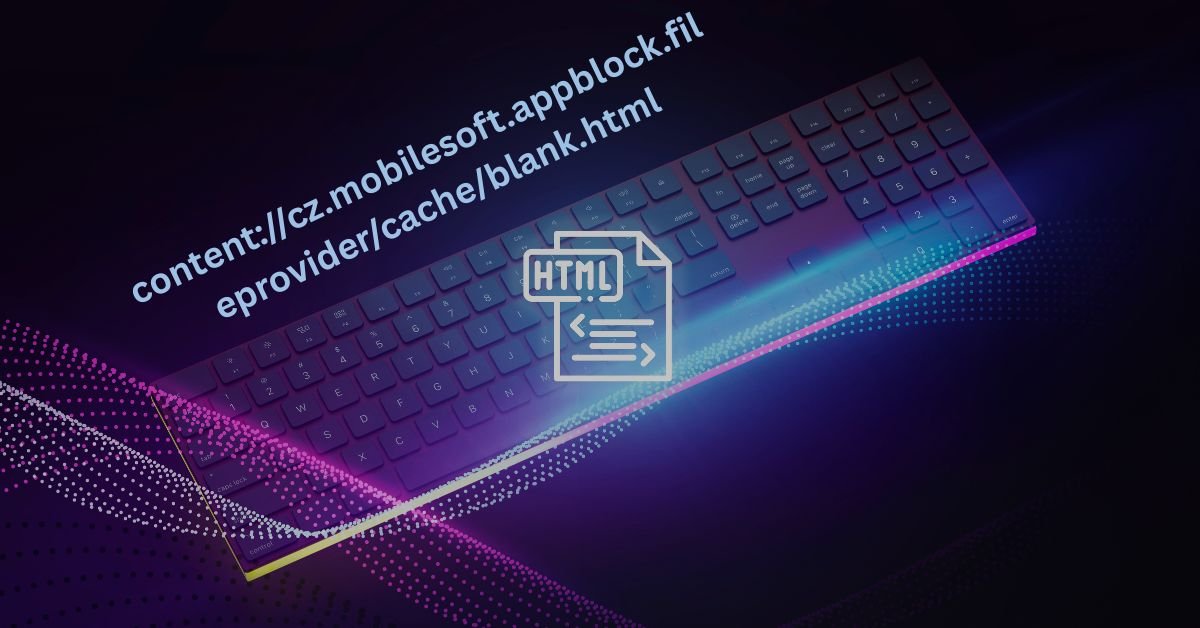The Android ecosystem often exposes internal file paths in the form of content URIs. One such path—content://cz.mobilesoft.appblock.fileprovider/cache/blank.html—has caught the attention of tech-savvy users and developers alike. Whether you stumbled upon this string through app logs, error messages, or developer tools, this guide will walk you through what it is, how to use it, why it looks, and what potential effects it might have on performance and security.
Let’s break it down for developers, Android users, and IT professionals, ensuring it aligns with E-A-T standards to deliver trustworthy and actionable information.
What Is content://cz.mobilesoft.appblock.fileprovider/cache/blank.html?
The URI content://cz.mobilesoft.appblock.fileprovider/cache/blank.html refers to a cached HTML file managed by the AppBlock app—a productivity and focus tool for Android users. AppBlock promotes improved focus and digital wellbeing by enabling users to ban distracting apps and websites.
This content URI points to a temporary HTML file (blank.html) generated or used internally by the app, often as a placeholder for blocked or restricted content.
In simple terms, it’s a placeholder page loaded when content is blocked—like a “nothing to see here” page.
Understanding Android’s Content URI System
Android uses
content://URIs as a means to share and access files between applications in a secure, sandboxed environment. Here’s a quick comparison to help you understand:
Type Example Purpose File Path /storage/emulated/0/...Direct access to internal/external storage URI Path content://...Indirect, secure access using a ContentProvider The format for a content URI is:
php-templateCopyEditcontent://<authority>/<path>/<file>In this case:
cz.mobilesoft.appblock.fileprovider= The content authority (AppBlock’s file provider)- The actual file location inside the application’s cache folder is cache/blank.html.
Breaking Down the File Path
Let’s dissect this particular URI to understand each part:
cz.mobilesoft.appblockThis is the package name of the AppBlock application, identifying its origin on the Play Store.
fileproviderAndroid’s FileProvider is a special type of
ContentProviderthat enables secure file sharing between apps.
cache/blank.htmlThis refers to a file named
blank.htmlinside the app’s cache directory—used as a placeholder or fallback HTML page.It’s not an actual webpage hosted on the internet—it’s a local, temporary file.
Where This URI Is Commonly Used
The AppBlock app can display this URI when:
- A webpage is being blocked
- A redirect occurs due to content filtering
- You inspect app logs or debugger tools
- Browsing restrictions are enforced using WebView
Fun Fact:
Some parental control apps also adopt similar behavior, replacing URLs with cached content like
blank.htmlto suppress access.Why It Shows Up in Logs or Apps
This path often appears in logcat, webview stack traces, or browser history for the following reasons:
- Blocked website: The original URL is replaced by
blank.html- Temporary redirection: A placeholder is loaded to avoid showing a 404 or error
- Internal WebView rendering: Apps render this when they can’t load external content
- Testing environments: Developers test this for sandboxed content rendering
For the average user, this path is benign and usually tied to intentional app functionality.
How to Use It – Step-by-Step Guide
If you’re a developer or a tech user trying to interact with or understand how this path works, follow these steps:
Step 1: Identify the App
Ensure that the AppBlock application is installed and has generated the cache file.
Step 2: Use Intent to Access
To access the file, you can use an
Intentin Android Studio or adb shell:
Step 3: Permission Handling
Add proper permission declarations in the manifest:

Step 4: File Access in ADB
If you’re debugging:

Step 5: Use in WebView
You can load the page into a WebView if needed:

Note: Your app must be authorized to access this URI.
Common Issues & Fixes
Issue Cause Solution File not found Cache cleared or app uninstalled Regenerate by opening AppBlock Permission denied Missing URI permission Add FLAG_GRANT_READ_URI_PERMISSIONWebView error No handler for content://Ensure WebView is configured to allow local content Security Implications
From a security standpoint,
content://cz.mobilesoft.appblock.fileprovider/cache/blank.htmlis relatively safe, but keep in mind:
- It doesn’t expose sensitive user data
- If mishandled, may lead to FileProvider vulnerabilities
- Avoid hardcoding sensitive URIs in production apps
- Always check that FileProvider is properly scoped with permissions
Performance & Compatibility Concerns
Here’s how this URI might impact your app or device performance:
- Cache Bloat: If not cleared, cached HTML files may consume space
- Device Compatibility: Works well on Android 7+; older devices might not support FileProvider properly
- WebView Issues: On some devices, WebViews may restrict local file rendering by default
To maintain optimal performance, clear app cache periodically.
Best Practices for Developers
If you’re implementing or interacting with similar content URIs in your Android apps, follow these tips:
- Always use FileProvider instead of direct file paths
- Manage cache lifecycle—delete unused files
- Verify permissions for inter-app content sharing
- Avoid exposing URIs to third-party apps unnecessarily
- Log access activity for debugging and auditing
FAQs
What is content://cz.mobilesoft.appblock.fileprovider/cache/blank.html used for?
It’s a cached placeholder HTML file used by AppBlock to display blank content when access is restricted.
Is content://cz.mobilesoft.appblock.fileprovider/cache/blank.html dangerous?
No. It’s a local, sandboxed URI that’s safe and controlled by the AppBlock app.
Can I open content://cz.mobilesoft.appblock.fileprovider/cache/blank.html in a browser?
No, not directly. An application with the appropriate permissions and FileProvider access is required.
Why do I see content://cz.mobilesoft.appblock.fileprovider/cache/blank.html in logs?
It appears when the app loads a blank placeholder due to blocking rules or redirection in WebView.
Can I delete content://cz.mobilesoft.appblock.fileprovider/cache/blank.html?
Yes, but only via the app’s cache clear option or by uninstalling AppBlock.
Final Thoughts
The mysterious-looking
content://cz.mobilesoft.appblock.fileprovider/cache/blank.htmlis neither harmful nor random. It is a fundamental part of how apps like AppBlock manage distractions and render safe content substitutes when blocking websites. For developers and users alike, understanding this URI can demystify a lot of behavior related to content access and mobile security.Used correctly, content URIs such as this one offer secure, efficient, and private ways to manage app data. However, they require proper handling to avoid permission issues or app crashes.
If you’re seeing this URI often and wondering about its impact—now you know it’s more about enhancing your digital wellness than anything shady.
